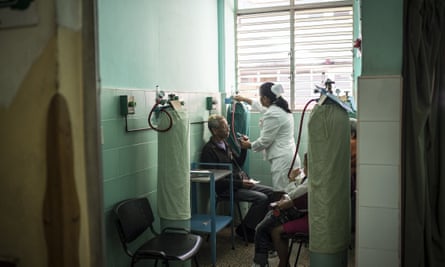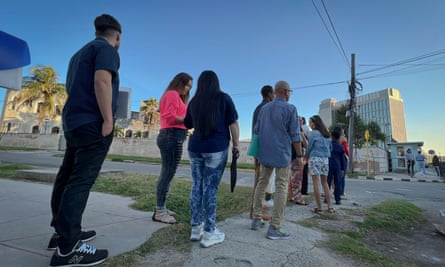Cuba health and education hollowed out as staff join emigration exodus
EEvery morning before dawn, hundreds of people line up in front of the US Embassy. On this particular day around noon, Acelia De La Osa, a frizzy-haired, 71-year-old retired science teacher, leaves the sleek modernist building and hugs her daughter. They both laugh with tears in their eyes: Acelia has a visa and will be in Florida soon.
Her daughter, Ana Delia, the only one of her siblings left on the island, also hopes to be released once her visa is received. An intensive care nurse, she has seen the purchasing power of her salary – now the equivalent of just $18 a month – halved by inflation over the past three years.
“Health and education are the two toughest sectors in this country,” she said. 'They pay you little and you work a lot.'
In addition to her small salary, she cited the amount of education her children now receive as another reason for wanting to leave. With a mass exodus of teachers from schools, there is no one to teach her 13-year-old twins math.
Government wages in Cuba have fallen sharply in recent years as US sanctions under “maximum pressure” have created huge deficits and fueled runaway inflation. Meanwhile, under-pressure public sector workers have more options than before: Emigration from the country is breaking records, while a resurgent private sector is sucking up much of the remaining talent.
As a result, the state is suffering an unprecedented brain drain: healthcare and education, long seen as the 'pillars' of the revolution, are fraying while qualified personnel are being drained.
At a school for autistic children in the capital's Vedado neighborhood, director Elsa Escalona, 72, has lost thirteen teachers in the past two years. Four have immigrated to the US – two with bachelor's degrees, two with master's degrees. She has had to increase the class size from the recommended five to nine students per class.
“You feel impotent because there is no way to convince people to stay,” says Escalona, who just survives on her and her husband's state salaries. “Some teachers have cried because they don't want to leave, but the economic situation is overwhelming – they feel they have to go.”
Cuba invests more in healthcare and education than any other Latin American country, and Cubans have enjoyed results in these sectors that rival those of developed countries for decades. But official figures show that the number of doctors, nurses and dentists is falling sharply. In October, the ministry of education announced that there was a shortage of 17,278 teachers.
Two years ago, the government allowed Cubans to set up businesses and import goods. Since then, the private sector, long reined in by the Communist Party, has bounced back and now employs more than a third of the island's workforce, according to economists. Small and medium-sized businesses, which pay many times more than the state and can employ up to a hundred people, are gobbling up many of the best and brightest.
Moreover, a new layer of US sanctions, implemented by Trump and largely maintained by Biden, has succeeded in their stated goal of providing hard currency to the Cuban economy. Economists say the new measures are costing the island's economy billions of dollars a year. As a result of the failed currency union three years ago, the economic damage caused by the pandemic and a highly dysfunctional planned economy, they have created a perfect storm.

“The conditions under which the government operates are impossible,” said Emily Morris, a development economist at University College London. “These new sanctions have caused a serious decline in living standards. Considering that one of the consequences of the sanctions is to hinder the government's access to international financing, they cannot do anything else because they have no foreign exchange buffer.”
Raúl Castro's government eliminated the need for an exit visa to leave the island in 2013, ending half a century of drastic travel restrictions. Until then, Cubans had to jump through bizarre bureaucratic hoops to migrate legally: Inspectors were often sent to people's homes to count knives, forks and spoons and only issued papers if the cutlery matched the registered number.
And in the past two years, more than 400,000 Cubans – about 4% of the island's population – have immigrated to the US. To address the influx of migrants at the southern border, the Biden administration in January unveiled a “humanitarian parole program” that will allow Cubans, Venezuelans, Nicaraguans and Haitians to apply with a sponsor from their country to temporarily live in the U.S. live and work.
More than 50,000 Cubans have already arrived through the program.
Once in the U.S., Cubans get a “jump start,” said Susan Eckstein, a professor of sociology at Boston University. Of the four nationalities eligible for the new parole program, she said, Cubans are the only ones for whom it serves as a path to legal permanent residency. “Cubans are also automatically eligible for benefits,” she added.

The relative ease with which Cubans can reach the US and the unique rights they have once they enter are, say analysts, a testament to the power of the Cuban-American lobby, which enjoys particular influence because it is rooted in the politically important stands. of Florida.
At an elementary school in Havana's Marianao neighborhood, teacher Fernando Rodríguez – who asked to use a pseudonym out of fear of reprisals – is feeling despondent. Free school meals for all pupils are still in place, but all seven of the school's computers are broken and there are shortages of pencils, erasers, textbooks – and teachers.
Since the semester started just three months ago, three of his colleagues have already left.
Ideally, he said, he would like to continue working as a teacher: he sees his work as important for future generations and loves how his students become his friends as they grow up.
But his monthly salary now only extends to buying a few dozen eggs on the black market.
“My dream,” he said, “is to emigrate.”
